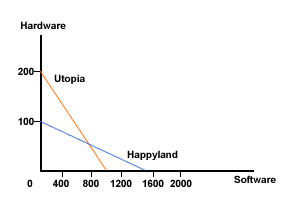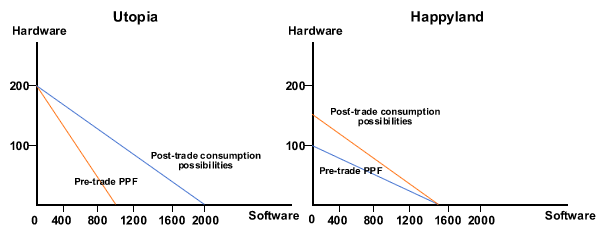Comparative advantage

According to David Ricardo (1772 - 1823) countries will benefit from trade, not only when they have an absolute advantage, but also if they have a comparative advantage. It would be always beneficial for two countries to trade if they have different relative costs (opportunity cost) of producing a good.

Comparative Advantage
A country has a comparative advantage in producing a good, if it is able to produce the good at a lower opportunity cost (by sacrificing less production of other goods) than other countries,
Comparative advantage theory
The theory of comparative advantage is based on the following assumptions:
- There are no trade restrictions
- There are no transport costs
- There are no exchange rates
Suppose there are two countries - Utopia and Happyland. These countries produce two products - hardware and software. According to the theory of comparative advantage each country should specialise in production of a good where it has a lower opportunity cost.
Pre trade situation and opportunity costs
The graph below shows production possibilities for Utopia and Happyland.

Figure 1 Production and consumption possibilities before trade
Assume that before trade each country uses a half of its resources to produce hardware and another half to produce software.
| Production and consumption | Hardware (units) | Software (units) |
|---|---|---|
| Utopia | 100 | 500 |
| Happyland | 50 | 750 |
| Total World | 150 | 1250 |
Utopia:
To produce 1 more Hardware Utopia has to give up 5 units of Software, e.g.
1 hardware = 5 Software
To produce software more Utopia has to give up 1/5 Hardware, e.g.
1 Software = 1/5 Hardware
Happyland:
To produce 1 more Hardware Happyland has to give up 15 units of Software, e.g.
1 hardware = 15 Software
To produce software more Happyland has to give up 1/15 Hardware, e.g.
1 Software = 1/15 Hardware
In conclusion, Utopia has a comparative advantage (lower opportunity cost) in production of Hardware and should specialise in production of Hardware.
Happyland has a comparative advantage (lower opportunity cost) in production of Software and should specialise in production of Software.
Specialisation
The table below shows specialisation based on comparative advantage.
| Hardware (units) | Software (units) | |
|---|---|---|
| Utopia (production) | 200 | 0 |
|
Happyland (production) |
0 | 1500 |
| Total production | 200 | 1500 |
Trade
As each country produces only one good, they will have to trade to be able to consume some of the other good. The terms of trade must settle somewhere between the two opportunity cost ratios to ensure that both countries benefit. As we saw earlier:
In Utopia 1 Hardware = 5 Software and in Happyland 1 Hardware = 15 Software, so the terms of trade (the world price) is 1 Hardware = 10 Software
If the countries agreed to trade 75 units of Hardware for 750 units of Software, then Utopia and Happyland will have the following amounts of Hardware and Software available for consumption:
| Hardware (units) | Software (units) | |
|---|---|---|
|
Utopia (consumption) |
125 | 750 |
|
Happyland (consumption) |
75 | 750 |
| Total production | 200 | 1500 |

Both countries are better off from specialisation and trade, because they can reach higher levels of consumption of both goods than was possible before specialisation. After trade they are both able to consume beyond their production possibility curves.
Limitations of comparative advantage theory
- Transport costs and tariffs and exchange rates may change the relative prices of goods and may distort comparative advantages.
- Imperfect competition may lead to prices being different to opportunity cost ratios.
- Comparative advantage theory is a static theory and does not take account of some of the more dynamic elements determining world trade. In particular, the factor of production capital is not a natural resource, and so may come outside the scope of the theory.

